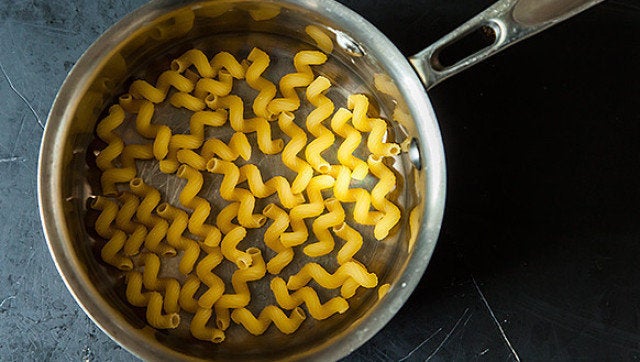
Inspired by conversations on the FOOD52 Hotline, we're sharing tips and tricks that make navigating all of our kitchens easier and more fun. Today, we're sharing three ways to cook pasta.
Grit your teeth, clench your jaw: do anything to keep from rolling your eyes. 'Do you think we're idiots?' you may be thinking. 'Of course I know how to boil pasta!'
Well, we've got 3 ways -- and they all work.
Whether you're a novice cook or as seasoned as a pot of pasta water, you've most likely cooked yourself a bowl of some kind of noodle. It was probably easy; it was probably good. But we've got tips on how to make it better -- and quicker, and even more energy-efficient.
Your eyes aren't rolling now, are they?
Read on for the classic way of boiling pasta -- then two more (crazy! blasphemous!) ways to play around with. Pasta can be new, exciting; there's no reason cooking it can't be the same.
Method #1: The Classic
Here's the way your nonna taught you, or your father, or the way you simply figured out by yourself -- with a few handy tips for good measure.
Take a big pot and fill it with 4-5 quarts of water. Salt it heartily, with enough to make it taste of the sea. This will season your pasta -- and is the only chance in your cooking process to do so. Once the water reaches a boil, toss your dried pasta in, and stir! Stir! Stir! The rigorous stirring in the beginning of the boiling process will keep the pasta from sticking to itself; the first few minutes of cooking are when the starches are released from the pasta, making the surface particularly sticky.
Once your pasta has the texture of a fresh stick of gum -- al dente -- take it out of the water, reserving some of the cooking liquid to add to your sauce (the starchiness will give your sauce extra body). If your sauce is getting cooked on the stove, add the pasta to the same pan, tossing it together before putting it in a serving bowl. This will allow the pasta to absorb some of the sauce -- and for the sauce to lap up any starch molecules still hanging onto the pasta.
Method #2: The Simmer
In 2009, Harold McGee wrote an article in The New York Times explaining that pasta can be cooked in a small amount of water -- around 1.5 quarts -- that starts out cold. Just salt the water as usual, put the pasta in the pot, and bring to a boil; the pasta will take around 10 minutes to cook through once the water reaches a boil.
Our friend Kenji Lopez-Alt over at The Food Lab took this one step further -- he proved that pasta can be cooked at a mere simmer (gasp!). What's more, a smaller volume of water yields a starchier pasta water at the end of cooking, which means it serves as an extra-effective binder.
Method #3: The Soak (a.k.a 60 Second Pasta)
The geniuses over at Ideas in Food, H. Alexander Talbot and Aki Kamozawa, figured out a way to cook pasta in 60 seconds.
Yes, 60 seconds.
First, put your dried pasta in a plastic bag or in a dish, cover it with cold water, and let it hang out for an hour and a half. Then, put a pot of salted, boiling water on the stove, toss in the soaked pasta, and wait 60 seconds.
Done! Al dente! And dinner is served.
Now that you inevitably have pasta on the brain, here are three of our favorite winter pasta recipes -- try one with each cooking method!